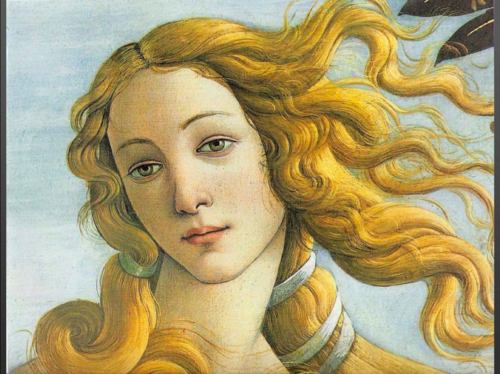














The author is a retired attorney and a still producing artist.
ACTUAL SLIDES ARE SHOWN ON THIS PAGE FOR YOUR REVIEW.
This is a very complete, highly visual and thoroughly annotated presentation on the Renaissance art movement.
EXCERPT: BULLET POINTS ON RENAISSANCE
~The Renaissance occurred in Europe, from the 14th to the 17th centuries, beginning in Florence in the 14th century.
~It started as a cultural movement in Italy and then spread to the rest of Europe.
~Its basis was humanism coupled with classical Greek philosophy.
~Humanism defined: an outlook attaching importance to the human rather than the divine.
~The Renaissance came after the Black Death (plague), which occurred in Europe between 1348 and 1350.
~Italy was very badly hit by the plague.
~This constant chain of death could have advanced Humanism by the survivors wanting to concentrate more on their lives on Earth, rather than on spirituality and the afterlife.
~The Renaissance affected art, architecture, politics, science and literature.
~Art was improved by adopting linear perspective, providing a naturally real look to the art works. Light and shadow were used. da Vinci studied human anatomy for his art.
~Although this era used to be presented as a cultural "advance" from the Middle Ages, that view has eroded in recent times.
~Now the two eras are looked upon as a continuum with a thousand ties between them.
~The Renaissance contained great art works about Christianity.
~Catholic Church patronized many works of Renaissance art.
~Yet intellectuals of the Renaissance began to look at religion differently, which eventually led to the Protestant Reformation.
~The stories, whether religious or mythical, are essential to this art style. Most of these figures have stories attached to them, which are given in the presentation whenever feasible.
ACTUAL SLIDES ARE SHOWN ON THIS PAGE FOR YOUR REVIEW.
This is a very complete, highly visual and thoroughly annotated presentation on the Renaissance art movement.
EXCERPT: BULLET POINTS ON RENAISSANCE
~The Renaissance occurred in Europe, from the 14th to the 17th centuries, beginning in Florence in the 14th century.
~It started as a cultural movement in Italy and then spread to the rest of Europe.
~Its basis was humanism coupled with classical Greek philosophy.
~Humanism defined: an outlook attaching importance to the human rather than the divine.
~The Renaissance came after the Black Death (plague), which occurred in Europe between 1348 and 1350.
~Italy was very badly hit by the plague.
~This constant chain of death could have advanced Humanism by the survivors wanting to concentrate more on their lives on Earth, rather than on spirituality and the afterlife.
~The Renaissance affected art, architecture, politics, science and literature.
~Art was improved by adopting linear perspective, providing a naturally real look to the art works. Light and shadow were used. da Vinci studied human anatomy for his art.
~Although this era used to be presented as a cultural "advance" from the Middle Ages, that view has eroded in recent times.
~Now the two eras are looked upon as a continuum with a thousand ties between them.
~The Renaissance contained great art works about Christianity.
~Catholic Church patronized many works of Renaissance art.
~Yet intellectuals of the Renaissance began to look at religion differently, which eventually led to the Protestant Reformation.
~The stories, whether religious or mythical, are essential to this art style. Most of these figures have stories attached to them, which are given in the presentation whenever feasible.
Something went wrong, please try again later.
This resource hasn't been reviewed yet
To ensure quality for our reviews, only customers who have purchased this resource can review it
Report this resourceto let us know if it violates our terms and conditions.
Our customer service team will review your report and will be in touch.
$5.00